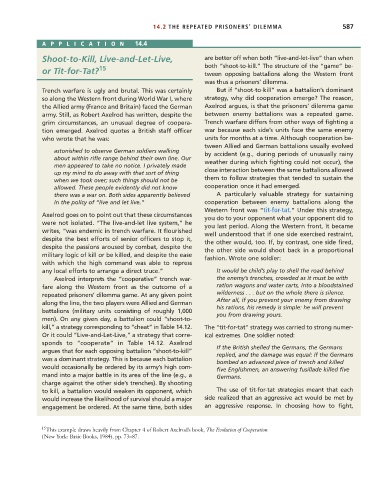Page 613 - Microeconomics, Fourth Edition
P. 613
c14gametheoryandstrategicbehavior.qxd 8/6/10 8:22 AM Page 587
14.2 THE REPEATED PRISONERS’ DILEMMA 587
APPLICA TION 14.4
Shoot-to-Kill, Live-and-Let-Live, are better off when both “live-and-let-live” than when
or Tit-for-Tat? 15 both “shoot-to-kill.” The structure of the “game” be-
tween opposing battalions along the Western front
was thus a prisoners’ dilemma.
Trench warfare is ugly and brutal. This was certainly But if “shoot-to-kill” was a battalion’s dominant
so along the Western front during World War I, where strategy, why did cooperation emerge? The reason,
the Allied army (France and Britain) faced the German Axelrod argues, is that the prisoners’ dilemma game
army. Still, as Robert Axelrod has written, despite the between enemy battalions was a repeated game.
grim circumstances, an unusual degree of coopera- Trench warfare differs from other ways of fighting a
tion emerged. Axelrod quotes a British staff officer war because each side’s units face the same enemy
who wrote that he was: units for months at a time. Although cooperation be-
tween Allied and German battalions usually evolved
astonished to observe German soldiers walking by accident (e.g., during periods of unusually rainy
about within rifle range behind their own line. Our
men appeared to take no notice. I privately made weather during which fighting could not occur), the
up my mind to do away with that sort of thing close interaction between the same battalions allowed
when we took over; such things should not be them to follow strategies that tended to sustain the
allowed. These people evidently did not know cooperation once it had emerged.
there was a war on. Both sides apparently believed A particularly valuable strategy for sustaining
in the policy of “live and let live.” cooperation between enemy battalions along the
Western front was “tit-for-tat.” Under this strategy,
Axelrod goes on to point out that these circumstances
you do to your opponent what your opponent did to
were not isolated. “The live-and-let live system,” he
you last period. Along the Western front, it became
writes, “was endemic in trench warfare. It flourished
well understood that if one side exercised restraint,
despite the best efforts of senior officers to stop it,
the other would, too. If, by contrast, one side fired,
despite the passions aroused by combat, despite the
the other side would shoot back in a proportional
military logic of kill or be killed, and despite the ease
fashion. Wrote one soldier:
with which the high command was able to repress
any local efforts to arrange a direct truce.” It would be child’s play to shell the road behind
Axelrod interprets the “cooperative” trench war- the enemy’s trenches, crowded as it must be with
fare along the Western front as the outcome of a ration wagons and water carts, into a bloodstained
repeated prisoners’ dilemma game. At any given point wilderness . . . but on the whole there is silence.
After all, if you prevent your enemy from drawing
along the line, the two players were Allied and German
his rations, his remedy is simple: he will prevent
battalions (military units consisting of roughly 1,000
you from drawing yours.
men). On any given day, a battalion could “shoot-to-
kill,” a strategy corresponding to “cheat” in Table 14.12. The “tit-for-tat” strategy was carried to strong numer-
Or it could “Live-and-Let-Live,” a strategy that corre- ical extremes. One soldier noted:
sponds to “cooperate” in Table 14.12. Axelrod
If the British shelled the Germans, the Germans
argues that for each opposing battalion “shoot-to-kill”
replied, and the damage was equal: if the Germans
was a dominant strategy. This is because each battalion
bombed an advanced piece of trench and killed
would occasionally be ordered by its army’s high com- five Englishmen, an answering fusillade killed five
mand into a major battle in its area of the line (e.g., a Germans.
charge against the other side’s trenches). By shooting
to kill, a battalion would weaken its opponent, which The use of tit-for-tat strategies meant that each
would increase the likelihood of survival should a major side realized that an aggressive act would be met by
engagement be ordered. At the same time, both sides an aggressive response. In choosing how to fight,
15 This example draws heavily from Chapter 4 of Robert Axelrod’s book, The Evolution of Cooperation
(New York: Basic Books, 1984), pp. 73–87.

